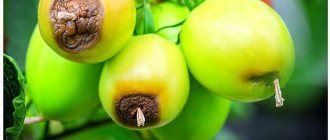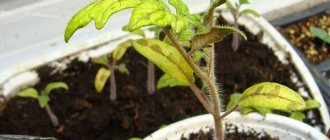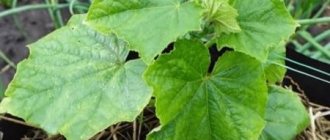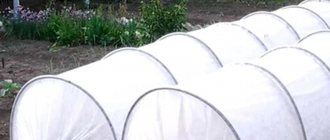Deformed cucumbers are not such a rare occurrence. Even experienced summer residents run the risk of encountering this problem. Why do cucumbers grow crooked? How can this be avoided? We will give you recommendations that will allow you to grow even cucumbers.
The illustration for the article is taken from open sources 457
Reason 1. Micronutrient deficiency
Curvature of cucumbers is often associated with a lack of microelements. As a rule, this crop lacks potassium or nitrogen. If you did not apply complex fertilizers to the soil during the season, it is possible that cucumbers also need other microelements.
Potassium deficiency
Plants often need potassium-based fertilizing, since its reserves in the soil are greatly depleted by the end of July. At night, the temperature changes, which negatively affects the absorption of this element. The fact that cucumbers need potassium replenishment is evidenced by their yellow tint and change in shape. At the same time, their leaves turn pale and curl downward.
In some cases, necrotic spots may appear. This problem can be solved by treating with a solution based on potassium salt. To prepare it, you need to dilute 25-30 g of the product in a bucket of water. You can start watering only after 4 days. After this, sprinkle with potassium sulfate. For 1 sq. m of ridge will require 40-60 g of the substance. You can also apply an ash-based solution under the bush (0.5 liters of ash per 1 bucket of water).
Related article:
Cucumber Siberian Garland F1 – description and characteristics of a super-yielding hybrid, reviews
The illustration for the article is taken from open sources
Nitrogen deficiency
If cucumbers do not have enough nitrogen, they become light green and narrow on the flower side, and, on the contrary, expand in the stalk area. In other words, their shape vaguely resembles a carrot. In addition, they noticeably lag behind in growth, harden, and their leaves become small and lose their brightness.
If you notice that cucumbers are growing deformed, spray them with a urea solution (5 g per 1 liter of water). After 5 days, fertilize the soil with ammonium nitrate. To prepare the fertilizer, you need to dilute 3 tbsp in 10 liters of water. l. of this substance. You need to be careful when applying these fertilizers, as excess nitrogen can lead to shedding of the ovaries.
Organic fertilizers are considered an excellent alternative. The mullein solution has proven itself to be the best. It is unacceptable to use it in its pure form. The product should be diluted in a ratio of 1:10. The source of nitrogen is a herbal infusion. Before pouring it over the cucumbers, you need to dilute it with water (1:10).
The illustration for the article is taken from open sources
Complex micronutrient deficiency
If several elements are missing at the same time, cucumbers take on an intricate shape. May resemble giant insects or a dumbbell. If you want the fruits to be even, treat the bushes with nitroammophos (25 g per 1 liter of water). You can begin subsequent processing only after 7 days.
The illustration for the article is taken from open sources
How to determine what cucumbers are missing
Cucumbers, like many other vegetables, require 3 groups of basic elements to grow:
- Macroelements - nitrogen, potassium, phosphorus are needed most by plants;
- Microelements are needed in microdoses, for example, zinc, manganese, boron;
- Mesaelements occupy an intermediate amount.
Each of the three macroelements is needed constantly throughout the growing season. Nitrogen is necessary for plants to grow green mass; its deficiency is expressed in small, light-colored foliage and thin stems. A sufficient amount of nitrogen is very important at the beginning of plant growth. The need for phosphorus is not so great; its deficiency slows down the growth of the plant, and the ovaries begin to fall off.
Content
- How to determine what cucumbers are missing
- Why do crooked cucumbers grow?
Cucumbers need the most potassium. Thanks to potassium, juices move and fruiting occurs. A lack of potassium is indicated by a yellow and then dried edge of the leaf blade. Cucumbers tend to grow crooked and ugly.
Potassium fertilizer is especially necessary for plants during the cucumber fruiting period in order to improve the taste of the product.
Reason 2. Improper watering
Cucumbers need to be provided with water at a comfortable temperature. If it is less than 25-28°C, this is fraught with a change in shape. Untimely watering also affects the fruits; they harden and curl. As soon as the ovaries appear, the bushes need to be watered every 2-3 days. After August 15, if the weather is good, you can carry out the procedure once every 7-14 days.
Related article:
The most important thing about the problems of cucumbers
If for some reason you are unable to moisten the soil regularly, but the summer is quite hot, use a drip irrigation system. Such a device has many advantages. It allows you to use water sparingly and reduces the risk of developing fungal diseases.
The illustration for the article is taken from open sources
Advice from experienced gardeners
Every gardener has at least once encountered hook cucumbers in the garden or in the greenhouse. Advice from experienced farmers will help you grow healthy, even and juicy fruits :
- Maintain crop rotation. The best predecessor crops for cucumbers are tomatoes, peppers, carrots, cabbage, and onions.
- For balanced moisture, mulch the soil with straw or peat after each watering.
- Stop watering when the air temperature is below 15 °C.
- Pick cucumbers 4–6 cm long from the vine.
- Once every two weeks, feed the cucumbers with an infusion of wood ash and potassium fertilizers.
- In late summer, use covered beds and greenhouses to avoid cold temperatures.
- Be sure to warm up water for irrigation in the sun, and in bad weather, boil and dilute with cold water.
- Carefully treat the greenhouse at the end of the season, disinfect it from diseases and pests that may have remained in the soil or located on the internal surfaces of the greenhouse.
Important! Water and spray cucumber bushes early in the morning (before 10:00) or in the evening (after 18:00). In hot weather, watering during the day may cause the plant to get sunburned.
Reason 3. Temperature changes
If cucumbers are grown outside a greenhouse in late August, you may find that they take on an hourglass shape. In this case, the reason lies in sudden temperature changes. It may still be hot during the day, but the nights are already cold. To prevent the fruits from changing their shape, provide them with protective cover at night.
The illustration for the article is taken from open sources
When grown in a greenhouse
In a greenhouse, cucumbers may taste bitter due to the following reasons:
- improper disinfection of the structure (the result is damage to plants by pests/diseases, which provokes increased production of a bitter substance);
- unfavorable soil composition for cucumbers;
- deficiency of sunlight or its excess;
- incorrect temperature conditions;
- high or low humidity levels;
- air stagnation or draft;
- dense planting, lack of space for growing the selected variety;
- improper care - insufficient watering, violation of the fertilizing schedule, refusal to hill up plants;
- choosing a variety prone to bitterness;
- damage to the lashes.
Reason 4. Under-pollination of cucumbers
If vegetables are not pollinated as expected, this is indicated by their hooked shape and uneven coloring. The fruits darken closer to the stalk and lighten in the flower area. To prevent this phenomenon, you can resort to artificial pollination.
If the moment when this needs to be done is missed, treat the bushes with a solution of boric acid (3 g per 1 liter of water). Remember that the key to a high-quality harvest is sowing seeds of self-pollinating varieties and hybrids.
The illustration for the article is taken from open sources
Prevention measures
To prevent vegetables from changing their characteristic shape and to protect yourself from crop loss, it is necessary to take preventive measures starting from the stage of planting seedlings.
The main precautions (based on the above reasons for curvature) will be the following:
- We store the seedlings in a moderately warm and bright place. The ideal temperature would be +20…+25°C. Cucumbers are a heat-loving and quickly ripening plant, so the higher the temperature, the faster the shoots will appear. But excess heat can also negatively affect seedlings, because after planting in open ground, the plant may experience stress due to a sharp temperature change.
- We choose a spacious, bright and moderately sunny place for the garden bed.
- We get acquainted with the type of variety and plant self-pollinating varieties with self-pollinating ones, and bee-pollinated varieties next to the same “neighbors.”
- After the first ovaries appear, it is necessary to mulch the soil and replenish it with complex fertilizers.
- Periodically loosen the soil and water regularly. Avoid drying out and forming a crust.
- If there is abundant growth, trim off excess sprouts and, if possible, distribute them evenly throughout the bed so that they do not overlap each other.
- We carry out timely and regular harvesting and remove overgrown fruits.
We recommend that you find out why cucumber ovaries turn yellow and how to deal with it.
It is always nice to serve healthy, beautiful food without traces of disease to the table. Smooth, juicy, neat cucumbers testify to the hard work and skill of their owner. In order to save your work and not lose precious time getting deformed fruits, you must not neglect the basic rules of caring for them. Only careful care will help you grow a healthy and useful harvest.
Reason 5. Incorrect fit
Not so rarely, inexperienced summer residents often make one mistake - they plant different varieties and hybrids of cucumbers close to each other. In this case, obtaining fruits of intricate shapes is a natural phenomenon. Never plant bee-pollinated or parthenocarpic varieties that do not require pollination next to each other. If you ignore this recommendation, partial cross-pollination and crossing of species will occur. As a result, you will end up with hooked specimens that are not entirely appropriate to use for preservation, since they will not be easy to remove from the jar. Before sowing the seeds, read the instructions.
Related article:
Growing cucumbers: in a barrel, hut and on a trellis
Do not plant regular and parthenocarpic varieties and hybrids next to each other. Follow the rules of crop rotation. Do not sow cucumbers in the same place as last year. As for predecessors, you can sow cucumbers in a bed that was previously occupied by white cabbage, cauliflower, tomatoes, potatoes, peas, and beets. It is not recommended to plant cucumbers in a place that previously belonged to pumpkin plants. This is only allowed after 4 years.
The illustration for the article is taken from open sources
When and what to feed cucumbers
A significant point in the process of growing cucumbers is proper feeding. The leaves of cucumber seedlings will curl if you do not follow all the recommendations for this process. Adding microelements to the soil is necessary before planting the plant in the soil and after. Before planting, it is recommended to weed the ground and fertilize it. Another important aspect is compliance with crop rotation.
The first application of fertilizers should be made after the appearance of the third cucumber leaf. You can use both organic and mineral substances. Manure and Ammophos are priority fertilizers.
Do the second feeding at the time when flowering begins. In this case use:
- phosphorus compounds;
- wood ash solution;
- boric acid.
It is recommended to check the vegetable for curled leaves. This will indicate the gardener's further actions. Wrinkled leaves require more attention and care. The third application of fertilizer occurs at the time of fruit formation. In this case, you need to use potassium nitrate and urea.
Stop fertilizing before the first harvest. When it is harvested, it can provide the soil with new nutrients to continue fruit formation and double the harvest.
On a note!
Moistened soil better conducts various nutrients to the roots of the plant. Therefore, you should water the cucumbers along with fertilizing.
Reason 6. Late harvest
Cucumbers should be collected every 2-3 days. If these intervals are extended, most of the fruit will become overripe and the plant will not be able to distribute nutrients. As a result, young cucumbers will surprise with their intricate shapes.
The illustration for the article is taken from open sources
All curled up
Curved fruits are formed as a result of a complex of factors. Most often this happens due to insufficient lighting - due to too dense planting, excessive development of side shoots (do not pinch), poor location of the greenhouse or bed in the shade of trees or buildings. Greens can become distorted due to insufficient nutrition, lack of nitrogen, phosphorus, potassium and magnesium in the soil. The appearance of bent fruits can be caused by low night temperatures. Also, damage to cucumbers can be caused by insect pests - aphids or thrips; if the damage is severe, the fruit may become deformed.
Quick help
Monitor the level of illumination of plants, pinch out side shoots in time. Do not forget about regularly feeding cucumbers with complex mineral fertilizers, alternating them with organic matter. Inspect the plants carefully and destroy pests in a timely manner. On fruit-bearing cucumber plants, this should be done with the help of biological preparations or infusions of insecticidal plants (onions, garlic, hot peppers, tobacco, mustard and others).
Many people only dream about it. How to harvest 200 kg of cucumbers from one bed Read more
Reason 7. Features of the variety
It is worth noting that in some cases, the curvature of the fruit is considered one of the varietal characteristics. As a rule, this is typical for late-ripening varieties and hybrids. Bend is also not considered a defect if you are growing Chinese cucumbers.
The illustration for the article is taken from open sources
If you want to please yourself and your loved ones in winter with preserved cucumbers in the form of even and equal-sized cucumbers, purchase planting material from trusted places and provide this crop with proper care.
https://www.youtube.com/watch?v=AiK1A3ST0iI
Diseases and pests
Cucumbers are often damaged by various infections and pests. The risk of a problem increases against the background of decreased immunity of cucumber plantings due to the following unfavorable factors:
- sudden change in air temperature;
- high humidity, excessive watering and cold water for irrigation;
- lack of lighting;
- growing cucumbers in a draft;
- violation of crop rotation rules;
- lack of micro- and macroelements necessary for development.
All these unfavorable factors significantly reduce immunity. The growth and formation of ovaries stops, the leaves of cucumbers curl and dry out.
The main diseases of cucumbers are powdery mildew, anthracnose, white, gray, root rot, downy mildew, green or white mosaic. Among the pests, melon aphids, spider mites, mole crickets, whiteflies, and tobacco thrips are often found.
Popular means of combating diseases include: “Fitolavin”, “Ridomil”, “Oxychom”, “Fundazol”, “Topaz”, Bordeaux mixture, “Ordan”.
There are many drugs to treat bushes with significant pest damage: “Fitoverm”, “Akarin”, “Aktelik”, “Commander”.
Compositions from folk recipes are considered effective. Solutions based on potassium permanganate, wood ash, kefir or whey, baking soda and salt are considered popular.
Powdery mildew
The appearance of a fungal disease such as powdery mildew can be noticed immediately. White spots appear on the inside of the lower leaves, and the leaf blades themselves may curl. Gradually, the disease spreads throughout the plant and it seems that the lashes are sprinkled with flour.
Cold and rainy weather, too thick plantings, excess nitrogen in the soil, watering with cold water, and the presence of weeds in the garden provoke the spread of infection.
It is better to cut off the affected leaves and remove them from the area. In case of infection of a large area of cucumbers, drugs such as Trichodermin, Oksikhom, Topsin, Fitosporin are used.
Root rot
The lower part of the cucumbers and the stem become brown, the leaves fade and become covered with yellow spots, there are few ovaries, they dry out and fall off, the cucumbers are formed in a deformed shape. Over time, the entire bush withers and dies.
Biological products (Gamair, Integral) cope with the disease, solutions based on Trichodermin and Glyokladin help. A popular recipe using chalk and vitriol is known from folk remedies.
Virus infection
Leaves may curl and turn yellow as a result of infection with viral infections. The most common viruses are white and green mosaic. The fruits and all parts of the plant are covered with mosaic spots. There may be white or yellow stripes. Aphids are often the carrier of infection.
Bushes affected by viral infections are poorly treated. It is better to pull out the affected seedlings by the roots and take them away from the site. Infected fruits should not be eaten. It is better to transplant the remaining seedlings to a new place.











